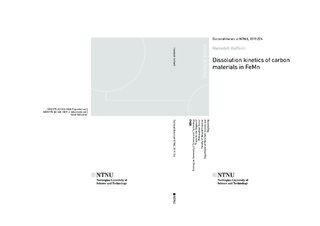| dc.description.abstract | Submerged electric arc furnace (SAF) is the main process for industrial production of ferroalloys, in which metal oxides are reduced by carbon. To decrease the production cost and reduce the CO2 emissions, a variety of carbonaceous materials is used including metallurgical cokes, charcoals and coals. The dissolution of carbon in metal in the coke bed area of the EAF is one of the important reactions and must be better understood. By understanding how carbon materials properties influence the rate at which carbon dissolves in metal we can predict the carbon’s performance. The carbon dissolution rate may also be an important factor when new processes with lower energy and CO2 emissions is developed.
As carbon dissolution rates have mainly been determined in iron, a systematic and comprehensive study was conducted on the dissolution of carbon from six cokes, charcoal and graphite into liquid Fe-Mn. The kinetics of carbon dissolution from cokes A to F was measured and a range of experimental techniques were used to elucidate the dominant factors affecting the dissolution rate. The role of carbon microstructure and macrostructure, coke inorganic matter composition and yield and temperature were investigated. Furthermore, the influence of interfacial products and dynamic wettability studies were also conducted.
The immersion rod method was used to measure carbon dissolution as a function of time at two different temperatures, 1450 and 1550°C. Fundamental data on the total carbon dissolution rate constant (kt) in molten Fe-85wt%Mn at 1550°C for cokes A to F were obtained and ranged from kt (× 103 m/s) = 48.9 to kt (× 103 m/s) = 67.3. For charcoal, kt (× 103 m/s) = 14.7 and for graphite kt (× 103 m/s) = 35.2. The wide variation in kt showed that not all carbon materials dissolve at similar rates.
Thermal annealing of carbonaceous materials above 1250 ºC significantly increased the degree of graphitization. This conclusion follows from a reduction of the interlayer spacing (d002) between aromatic planes, an increase of the stack height (Lc) of graphite crystallites, and an increased G fraction in the Raman spectra. Since the crystallite size of cokes at v1550°C were quite close, the difference in their dissolution rate cannot be explained on the basis of different microstructure. Within poorly ordered carbon materials like cokes and charcoal, with increasing crystallite size the dissolution rate increased.
Increasing surface roughness, porosity and BET of different cokes, slightly increased the dissolution rate. Surface roughness of carbon materials also affected the wettability between cokes and Fe-Mn metal. With increasing roughness of non-wetting system, that is the cokes, the wettability decreased and with increasing surface roughness of wetting systems, that is graphite and charcoal, wettability increased.
Wettability experiments were carried out using the sessile drop technique. The wettability of cokes C, D, E and F and charcoal with liquid Fe-85wt%Mn was measured as a function of time from the melting point (1300°C). All coke samples showed wetting behavior with contact angles ranging between 60-65° in the initial stages (at the time of melting) and between 95-110° after 30 minutes of contact. Wettability of cokes with Fe-Mn at the initial stage can explain the high dissolution rate of the cokes.
The sessile drop technique was also used to study the interfacial products formed at the coke/metal interface. Interfacial products formed between the coke and the metal, after contact with cokes C and E. The cokes were initially different in regard to the morphology and chemical composition. The interfacial product formed with coke E had a network or mesh like structure that seemed to cover the metal droplet much better than the interfacial product formed with coke C. In contrast, globules and discrete interfacial products were observed in coke C. It was suggested that this was due to differences in inorganic matter content, especially in sulfur (S) content in the coke.
Dissolution mechanism was believed to be both interfacial reactions and carbon mass transfer in boundary layer. As the carbon microstructure and macrostructure affected the dissolution rate, the interfacial reactions are affecting the dissolution rate limiting step. Some indications such as metal composition and temperature dependence supported the carbon mass transfer to affect the dissolution rate limiting step. | nb_NO |
